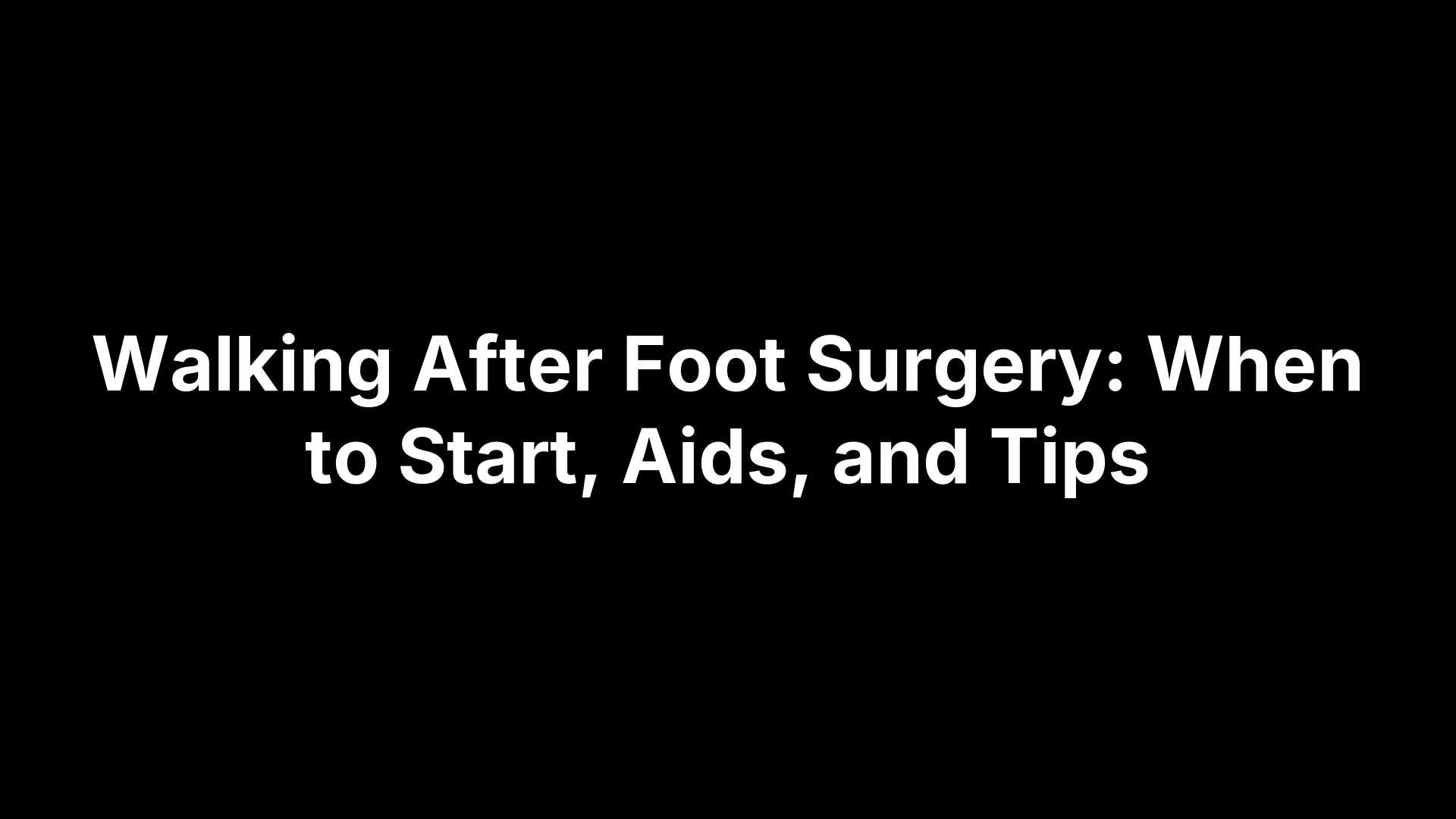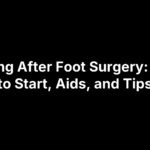Feeling unsteady, shuffling your steps, or tiring quickly on walks? Changes in gait often creep in after an ankle sprain, arthritis flare, surgery, neuropathy, or simply years of compensating in unsupportive shoes. The result can be shorter steps, poor balance on turns, and a growing fear of falls that keeps you from the activities you love. The good news: gait and balance are trainable. With targeted exercises and small equipment and environment tweaks, most people can walk farther, steadier, and with less foot and ankle pain.
In this guide, you’ll get five podiatrist-approved tips you can put to work today: a professional gait assessment and custom plan (including how our team at Achilles Foot and Ankle Center can help), a 10-minute strength and mobility routine, progressive balance and proprioception drills, gait-specific and dual-task training, and smart upgrades to footwear, orthotics, assistive devices, and your home setup. Each tip includes step-by-step instructions, safety cues, and ways to measure progress. Ready to move with confidence? Start with a clear look at how you walk.
1. Get a podiatry gait assessment and custom plan at Achilles Foot and Ankle Center
If you’re wondering how to improve gait without guessing, start with a targeted evaluation. Our podiatrists look at the foot and ankle mechanics that drive shuffling, dragging, hitching, or short steps and build a plan that restores range of motion, strength, balance, and confidence—often reducing pain along the way.
Why it helps your gait
A proper assessment finds the root cause—limited ankle dorsiflexion, weak calves or hip stabilizers, painful joints, or poor footwear—so your plan fixes what’s actually limiting your stride. Evidence-based gait training focuses on strength, flexibility, balance, and coordination to improve step length, speed, and stability.
- Address the cause: Treat mechanics behind short steps, toe-out, pronation/supination, or shuffling.
- Targeted exercises: Prioritize the muscles and motions you need for heel strike, mid-stance, and push-off.
- Immediate wins: Footwear, bracing, or orthotics can stabilize your base while you retrain.
How to do it step-by-step
Start by booking an appointment at a nearby Central Virginia location. Bring the shoes you wear most days and any inserts, plus a medication list and fall history.
- History + exam: Pain points, prior injuries, and goal setting.
- Movement screen: Foot/ankle ROM, strength, and single-leg balance.
- Gait observation: Step length, cadence, foot progression angle, and stability on turns.
- Custom plan: Daily 10-minute routine, balance work, gait drills (e.g., sidestepping, target stepping, retro walking), footwear/orthotics, and follow-up.
- As needed: Imaging, bracing, physical therapy, or injections.
Safety tips and when to stop
Your plan will scale to your current capacity. Stop and contact us if pain spikes, swelling or redness increases, you feel dizzy, or notice new numbness or [foot drop](https://achillesfootandankle.com/our-services/foot-drop/). Use a counter, rail, or assistive device as prescribed, and keep sessions short at first.
- Rule of thumb: Discomfort is okay; sharp pain isn’t.
- Set up: Clear obstacles; wear supportive shoes; keep water nearby.
Ways to progress and measure improvement
Track what matters weekly so you can see gains and fine-tune your plan.
- Balance: Single-leg stance time (eyes open, then closed).
- Walking: Comfortable speed over a set distance and step count.
- Function: Timed Up and Go and obstacle clears without taps.
- Symptoms: Pain/fatigue ratings and fewer stumbles or near-falls.
- Progression: Add reps/sets, narrow stance, vary surfaces, or introduce safe retro walking with a treadmill safety key and supervision.
2. Do a daily 10-minute strength and mobility circuit
A short, consistent routine builds the ankle mobility and lower-body strength your gait relies on from heel strike through push-off. Done daily, this circuit targets calves, quads, hips, and feet to lengthen your step, steady your stance, and reduce “shuffle” without exhausting you.
Why it helps your gait
Gait training works when it blends range-of-motion and strengthening. Ankle dorsiflexion drills (to clear the toes), calf and quad work (for push-off and knee control), and hip activation (to stabilize the pelvis) are proven components that improve step length, speed, and balance.
How to do it step-by-step
Complete the six moves below as a circuit (about 5 minutes), rest 60 seconds, then repeat once for a 10-minute session.
- Ankle pumps (60 seconds): Flex and point both ankles rhythmically to warm up and reduce stiffness.
- Calf towel stretch (30 seconds each): Seated, loop a towel midfoot and gently pull to feel a calf stretch.
- Sit-to-stand (8–12 reps): From a sturdy chair, stand without using hands if able; control the descent.
- Seated knee extensions (8–12 reps/leg): Straighten one knee to parallel with the floor; lower slowly.
- Calf raises (12–15 reps): Holding a counter, rise onto toes; pause at the top, lower with control.
- Sidestepping along a counter (2 passes each way): Step out then in, keeping hips level and knees soft.
Safety tips and when to stop
Wear supportive shoes, use a counter or chair for balance, and clear your space. Mild muscle effort is expected; stop if you feel sharp pain, new swelling/redness, dizziness, numbness, or foot drop. Swap step-ups with high-knee marching if stairs aggravate your knees.
Ways to progress and measure improvement
- Progression: Add a third round, slow the lowering phase, hold calf raises at the top, or add light ankle weights.
- Measures: Track reps completed with good form, time for 10 sit-to-stands, ankle flexibility (easier heel-to-floor), and fewer toe catches or stumbles on walks.
3. Practice balance and proprioception with progressive challenges
If you’re working on how to improve gait, balance and proprioception are your foundation. Proprioception—your body’s sense of joint position—keeps you steady during single‑leg stance, turns, and uneven ground. Train it in small, controlled doses and you’ll notice fewer stumbles, smoother step placement, and more confident walking.
Why it helps your gait
Every step includes a brief single‑leg balance. Targeted balance work strengthens ankle and hip strategies, improves foot placement over obstacles, and enhances coordination—key for safe heel strike, mid‑stance stability, and push‑off. Simple drills like single‑leg stance, heel‑to‑toe (tandem) walking, sidestepping, and target stepping are proven components of gait training.
How to do it step-by-step
Start near a counter for light support and wear supportive shoes.
- Single‑leg stance (3 x 10–20s/side): Stand tall, lift one foot, hold, switch.
- Tandem walk (2–3 passes of 10–15 steps): Walk a line, heel directly to toe.
- Sidestepping (2 passes each way): Along a counter; hips level, soft knees.
- Target taps (8–10 taps/foot): Place small paper targets in a semicircle; tap lightly and return.
Safety tips and when to stop
Use fingertip support as needed and clear the area of clutter. Avoid eyes‑closed work until you can hold positions steadily. Stop and rest if you feel sharp pain, new swelling, dizziness, numbness, or increased foot drag; resume only when symptoms settle.
Ways to progress and measure improvement
- Progression: Reduce hand support, narrow tandem steps, add low obstacles (rolled towels), stand on a firm cushion, then try brief eyes‑closed holds.
- Measure: Track single‑leg stance time, step “wobbles” on tandem, obstacle clears without bumps, and smoother turns with fewer near‑falls across the week.
4. Add gait-specific drills and dual-task training
Once you’ve built strength and balance, practice the exact skills of walking: precise foot placement, timing, direction changes, and attention while moving. Gait-specific drills paired with simple cognitive tasks make your stride more automatic, smoother, and safer in real-life environments.
Why it helps your gait
Stepping over obstacles, target stepping, and sidestepping sharpen coordination and hip/knee lift for toe clearance. Backward (retro) walking challenges toe‑to‑heel control and has been shown to improve balance, coordination, and even step length and speed. Adding dual‑tasks (thinking while walking) better prepares you for everyday distractions.
- Mimics real life: Obstacles, turns, and speed changes reflect sidewalks, stores, and stairs.
- Refines timing: Reinforces heel strike, mid‑stance stability, and push‑off.
- Builds resilience: Dual‑tasking reduces slowdowns and stumbles when multitasking.
How to do it step-by-step
Begin with light hand support at a counter or rail.
- Obstacle walk: Line up 5–6 low obstacles ~15 inches apart; step over each, place feet together, turn, then lead with the other foot.
- Target stepping: Place 4–5 floor targets in a semicircle ~1 foot apart; lightly tap each and return to start.
- Sidestepping: Travel along a counter with hips level and knees soft.
- Retro walking: On a treadmill at the slowest speed with the safety key, face backward and step toe‑to‑heel; or walk backward along a counter.
- Direction + speed changes: Add figure‑8s, 90° turns at cones, and brief bouts of slow/normal/fast pace.
- Dual‑task add‑ons: Count backward, name categories, turn your head to “scan,” or carry a half‑filled cup.
Safety tips and when to stop
Keep the area clear, wear supportive shoes, and use a spotter for new drills or retro walking. Start low and slow with obstacles. Stop if you feel dizzy, have sharp pain, new swelling, numbness, or repeated toe catches; resume only after symptoms ease.
Ways to progress and measure improvement
- Progression: Reduce hand support, raise obstacle height slightly, tighten target spacing, lengthen figure‑8s, and add more complex dual‑tasks.
- Measure: Count obstacle clears without taps, time a short course, note steadier turns, track fewer stumbles, and compare walking speed with and without a dual‑task to see better carryover.
5. Optimize footwear, orthotics, assistive devices, and home setup
Your base matters. The right shoes, supportive inserts, and—when appropriate—an assistive device create immediate stability so your training “sticks.” A safer home layout reduces unnecessary trips and stumbles, helping you focus on smoother steps and better balance as you practice how to improve gait each day.
Why it helps your gait
Supportive footwear and orthotics align the foot, reduce pain, and improve heel strike, mid‑stance, and push‑off. Canes and walkers add external stability during retraining, while simple environment tweaks lower fall risk so you can progress reps, speed, and distance with confidence.
How to do it step-by-step
Start with what you wear and where you walk before you add more reps.
- Upgrade shoes: Choose a firm heel counter, midfoot stiffness, good traction, low heel, and enough depth for inserts.
- Fit orthotics/bracing: Your podiatrist can prescribe custom or prefabricated inserts or an ankle brace to correct mechanics and unload sore tissues.
- Select a device (if needed): Cane or walker based on your balance; practice indoors first along a countertop, then short hallways.
Safety tips and when to stop
Test changes one at a time so you know what helps. Break in new shoes/inserts gradually and check your skin.
- If you notice hot spots, redness, numbness, sharp pain, or dizziness, stop and contact your clinician.
- At home: Clear clutter, secure loose rugs, add night lights, and use handrails for stairs.
Ways to progress and measure improvement
As strength and control improve, your clinician may adjust supports.
- Progression: Move from walker to cane to no device as approved; advance to lighter, more flexible shoes once gait is stable.
- Measure: Fewer near‑falls, steadier turns, longer walks with less fatigue, and faster comfortable walking speed over a set distance.
Move with confidence
Picture your next walk—longer, smoother steps, steadier turns, and the confidence to enjoy errands, parks, or time with family. Start small: do the 10‑minute circuit, add one balance drill, and tighten up your footwear choices. Track simple wins each week—fewer stumbles, faster comfortable pace, and easier turns—and you’ll see steady progress. If pain, numbness, frequent near‑falls, or diabetes are in the mix, get a podiatry‑led assessment and a custom plan. Our team at the Achilles Foot and Ankle Center offers comprehensive gait evaluations across multiple Central Virginia locations, with personalized exercises, footwear/orthotics guidance, and follow‑up care so you can move with confidence again.






